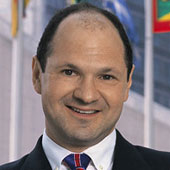Moscow on the Hudson
Why does the New York City skyline recall communist times?
September 12, 2000
In the 1960s and early 1970s, pundits talked about the communist and capitalist systems eventually converging and becoming practically indistinguishable from one another. In the West, state ownership was supposed to increase — and large corporations were expected to stifle private competition, creating a system not unlike the monopolistic command economy of the Soviet Union and other communist states.
But things didn’t quite work out this way. Actually, reality proved exactly the opposite. The supply-side revolution of the 1980s intensified competition everywhere in the West, whereas the uncompetitive communist system stagnated and eventually collapsed under the weight of its own inefficiency. State ownership, cradle-to-grave social welfare have become discredited even in Western Europe. Political control is on its way out everywhere, even in developing countries.
But strangely, one of the ugliest physical vestiges of communism seems to be flourishing in a surprising place — New York City. The city is booming, and new apartment buildings pop up on every available square foot of real estate.
Yet, the more the island of Manhattan becomes the playground of the rich and famous, the more those buildings come to resemble the dreary residential blocks that sprung up on the outskirts of every city in Eastern Europe and the former Soviet Union during the decades of communism.
There are huge differences, of course. Manhattan buildings have marble-faced lobbies with live flowers and uniformed doormen. They charge mind-boggling rents — minimums of $3,000 per month for a tiny studio apartment and $5,500 for a two-bedroom are the norm.
But these overpriced high-rises feature the same shoddy construction, the cheapest possible materials, the low ceilings and the cookie-cutter designs as the Soviet apartment buildings. Walls are thin enough to hear your neighbor’s every move — and cost-cutting architectural designs ensure that there is no cross-ventilation mean that a typical New York summer is unbearable, even with the air conditioning blowing full blast.
To make room for those aesthetic and functional monstrosities, developers bulldozed quirky low-rise buildings that housed unusual businesses and helped make New York so appealing. This too makes the current Manhattan boom similar to the communist building methods, where everything from the bourgeois past was razed to the ground.
Where does the similarity come from? After all, New York is the self-proclaimed capital of greed and the center of the world. Besides, its recent economic success has been derived not so much from the traditional stalwarts — financial services, advertising and publishing — but from the “new economy.” The Silicon Alley on lower Broadway has provided the bulk of recent jobs growth.
The Soviet government kept its citizens inside the Soviet Union by force and used its monopoly on political and economic power to keep them pauperized. Manhattan apartment dwellers are free to go, of course, and the only reason why they choose to stay in overpriced apartments is snobbery associated with a New York City zip code. Also, unlike workers under communism, they are, supposedly, extremely well paid.
Nevertheless the end result is strikingly similar. After they finish paying their rents, even better paid Manhattanites end up not much richer than a petty communist bureaucrat. And beggars, of course, can’t hope to get high-qualities goods and services, including decent housing.
Read previous
Une Affaire de Coeur
September 11, 2000
